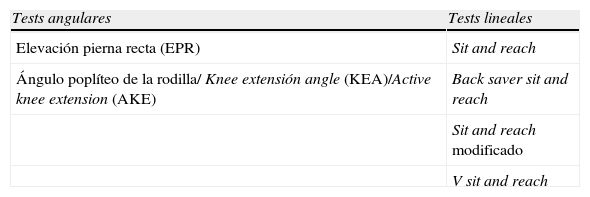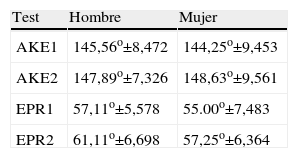Establecer la relación entre los test de elevación de pierna recta (EPR) y active knee extension (AKE, «ángulo poplíteo») en la medición de la extensibilidad isquiosural, determinar el grado de fiabilidad de cada test, determinar la influencia ejercida de un test sobre otro y establecer el grado de extensibilidad isquiosural en los universitarios, así como las diferencias entre géneros.
Material y métodoSe ha llevado a cabo un diseño experimental aleatorio transversal. 19 sujetos, 11 mujeres y 8 hombres, se presentaron voluntariamente al estudio. De ellos, 2 mujeres fueron excluidas por haber padecido dolor lumbar en el último mes. Fueron repartidos en dos grupos de forma aleatoria, un grupo fue sometido al test EPR seguido del AKE, mientras que el grupo 2 fue sometido al test AKE seguido del EPR, con 6min entre test y test, con dos intentos para cada test con 1min entre ensayo y ensayo.
ResultadosNo encontramos una relación estadísticamente significativa entre AKE y EPR, medida por un coeficiente de determinación del 0,420. En cuanto a fiabilidad, los resultados fueron 0,866 en AKE y de 0,741 en EPR. La realización de un test no condicionó el resultado del siguiente test y se hallaron resultados más altos en el hombre con respecto a la mujer.
ConclusiónEPR y AKE no miden por igual la extensibilidad isquiosural, siendo AKE más fiable que EPR. Un test no influyó en la realización posterior del otro y se encontraron datos más altos de extensibilidad en hombres que mujeres, siendo necesaria más investigación para poder concluir sobre este aspecto.
To determine the relationship between straight leg raise (SLR) test and active knee extension (AKE) in hamstrings flexibility measurement, reliability of each test, influence of one test over the other and establish the differences between the university students and gender in hamstrings range of motion.
Materials and methodsA randomized, cross-sectional, experimental design study was conducted. Nineteen healthy subjects (11 women, 8 men) voluntarily participated in the study. Two women were excluded to de having had low back pain in the last month. The subjects were randomly assigned to groups 1 and 2. Group 1 performed the SLR first and then the KEA and Group 2 performed the KEA first and then the SLR. The subjects had 6min between the two test, with two attempts for each test with a one-minute rest period SLR1 and SLR2 and AKE1 and AKE2, respectively.
ResultsThere was no statistically significant relationship between AKE and SLR measurements, with a coefficient of determination of 0.421. Reliability of SLR was 0.741 and 0.866 in AKE. No influence was found between both test and we found a higher range of movement in the male than in female.
ConclusionsSLR and AKE does not measure hamstrings flexibility equally. We obtained more reliable results with the AKE. One test did not influence the subsequent performance of the other and higher data on extensibility were found in men than in women. However, future research is needed to make a conclusion on this aspect.
Artículo
Si ya tiene sus datos de acceso, clique aquí.
Si olvidó su clave de acceso puede recuperarla clicando aquí y seleccionando la opción "He olvidado mi contraseña".Comprando el artículo el PDF del mismo podrá ser descargado
Precio 19,34 €
Comprar ahora

















